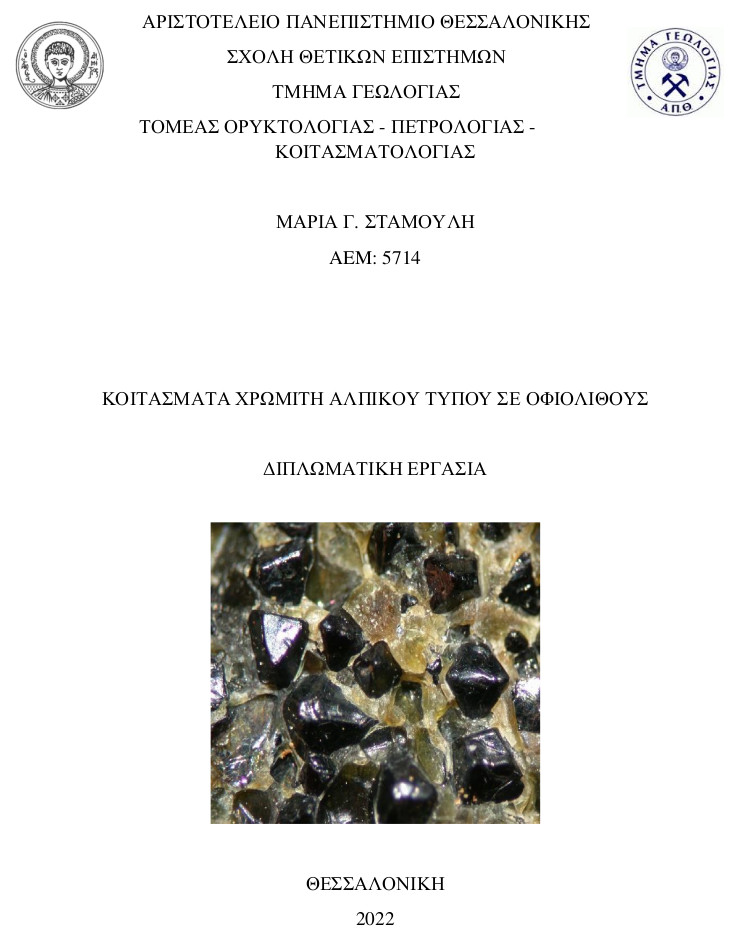
Κοιτάσματα χρωμίτη Αλπικού τύπου σε οφιολίθους = Podiform chromite deposits in ophiolites.
Περίληψη
Chromium is a chemical element that is widely used in industry and the costructions. Its primary source is chromite deposits, characterized by high amounts of chromium oxides. The aim of this Bachelor thesis is the review of podiform chromite deposits found in ophiolite complexes. After presenting the basic characteristics of chromium as a chemical element, extensive reference is made to chromite, its main sources, and the rocks in which it forms, the ophiolites. The thesis continues by presenting basic characteristics of the deposits, citing information about the geotrctonic environments in which they are formed and the form we find them in the field. As a final part of the review, important deposits of this type are presented, from worldwide as well as from Greece. From this analysis it was found that the study and clarification of the nature and appearance of these deposits is substantial, both for the global industry and for understanding of their role in the geotectonic evolution of continents.
Πλήρες Κείμενο:
PDFΑναφορές
Andal, E. S., Arai, S., & Yumul Jr, G. P. (2005). Complete mantle section of a slow‐spreading ridge‐derived ophiolite: An example from the Isabela ophiolite in the Philippines. Island Arc, 14(3), 272-294.
Barcza, N. A., Boyes, M., Clarke, N. R., Johnson, C., & Van Der Merwe, A. J. THE DEVELOPMENT OF THE VOSKHOD CHROME PROJECT IN KAZAKHSTAN. Brown, D., Ryan, P. D., Afonso, J. C., Boutelier, D., Burg, J. P., Byrne, T., ... & Zagorevski, A. (2011). Arc-continent collision: the making of an orogen. In Arc-continent collision (pp. 477-493). Springer, Berlin, Heidelberg.
Bussolesi, M., Grieco, G., Cavallo, A., & Zaccarini, F. (2022). Different tectonic evolution of fast cooling ophiolite mantles recorded by olivine-spinel geothermometry: Case studies from Iballe (Albania) and Nea Roda (Greece). Minerals, 12(1), 64.
Cassard, D., Nicolas, A., Rabinovitch, M., Moutte, J., Leblanc, M., & Prinzhofer, A. (1981). Structural classification of chromite pods in southern New Caledonia. Economic Geology, 76(4), 805-831.
COLEMAN, R. G. (1977): Ophiolites, Ancient Oceanic Lithosphere? Springer-Verlag, Heidelberg, New York.COLEMAN, R. G. (1977): Ophiolites. Springer Verlag. New York. p. 220.
Dilek, Y., & Furnes, H. (2011). Ophiolite genesis and global tectonics: Geochemical and tectonic fingerprinting of ancient oceanic lithosphere. Bulletin, 123(3-4), 387-411.
Economou, M. I., & Naldrett, A. J. (1984). Sulfides associated with podiform bodies of chromite at Tsangli, Eretria, Greece. Mineralium Deposita, 19(4), 289-297.
Gervilla, F., Fanlo, I., Kerestedjian, T. N., Castroviejo Bolíbar, R., Padrón, J. A., Rodrigues, J. F., & González-Jiménez, J. M. (2011). Origin of ferrian chromite in metamorphosed podiform chromites: a two-stage process. In 11th SGA Biennial Meeting: Let's Talk Ore Deposits.
Grieco, G., & Merlini, A. (2012). Chromite alteration processes within Vourinos ophiolite. International journal of earth sciences, 101(6), 1523-1533.
Johnson, C. (2012). Podiform chromite at Voskhod, Kazakhstan (Doctoral dissertation, Cardiff University).
Lunk, H. J. (2015). Discovery, properties and applications of chromium and its compounds. ChemTexts, 1(1), 1-17.
Miyashiro, A. (1975). Classification, Characteristics, and Origin of Ophiolites. The Journal of Geology, 83(2), 249-281. http://www.jstor.org/stable/30060218Morishita, T., Andal, E. S., Arai, S., & Ishida, Y. (2006). Podiform chromitites in the lherzolite‐dominant mantle section of the Isabela ophiolite, the Philippines. Island Arc, 15(1), 84-101.
Mosier, D. L., Singer, D. A., Moring, B. C., & Galloway, J. P. (2012). Podiform chromite deposits—database and grade and tonnage models. US Geological Survey Scientific Investigations Report, 5157, 45.
Paktunc, A. D. (1990). Origin of podiform chromite deposits by multistage melting, melt segregation and magma mixing in the upper mantle. Ore Geology Reviews, 5(3), 211-222.
Papp, J. F., & Lipin, B. R. HANDBOOK OF CHEMICAL INDUSTRY ECONOMICS, INORGANIC.
Pinti D.L. (2011) Serpentinization. In: Gargaud M. et al. (eds) Encyclopedia of Astrobiology. Springer, Berlin, Heidelberg. https://doi.org/10.1007/978-3-642-11274-4_1430.
Prichard, H. M., Barnes, S. J., Godel, B., Reddy, S. M., Vukmanovic, Z., Halfpenny, A., ... & Fisher, P. C. (2015). The structure of and origin of nodular chromite from the Troodos ophiolite, Cyprus, revealed using high-resolution X-ray computed tomography and electron backscatter diffraction. Lithos, 218, 87-98.
Rospabé, M., Ceuleneer, G., Granier, N., Arai, S., & Borisova, A. Y. (2019). Multi-scale development of a stratiform chromite ore body at the base of the dunitic mantle-crust transition zone (Maqsad diapir, Oman ophiolite): The role of repeated melt and fluid influxes. Lithos, 350, 105235.
Schulte, R. F., Taylor, R. D., Piatak, N. M., & Seal II, R. R. (2012). Stratiform chromite deposit model: Chapter E in Mineral deposit models for resource assessment (No. 2010-5070-E). US Geological Survey.
Shekhawat, K., Chatterjee, S., & Joshi, B. (2015). Chromium toxicity and its health hazards. International Journal of Advanced Research, 3(7), 167-172.
Zhou, M. F., Robinson, P. T., & Bai, W. J. (1994). Formation of podiform chromitites by melt/rock interaction in the upper mantle. Mineralium Deposita, 29(1), 98-101.
Zhou, M. F., Robinson, P. T., Su, B. X., Gao, J. F., Li, J. W., Yang, J. S., & Malpas, J. (2014). Compositions of chromite, associated minerals, and parental magmas of podiform chromite deposits: The role of slab contamination of asthenospheric melts in suprasubduction zone environments. Gondwana Research, 26(1), 262-283.
Γιαννακοπούλου, Π. (2019). Μελέτη των οφιολιθικών πετρωμάτων των Γερανείων Ορέων και της Γευγελής. Η επίδραση των μικροπετρογραφικών, γεωχημικών και φυσικομηχανικών χαρακτηριστικών στην ποιότητα τους ως αδρανών υλικών (Doctoral dissertation).
Εμμανουηλίδης, Χ. (2019). Μεταλογέννεση μεταξύ Βεροίας και Ναούσης περιοχής (Doctoral dissertation, Αριστοτέλειο Πανεπιστήμιο Θεσσαλονίκης (ΑΠΘ). Σχολή Θετικών Επιστημών. Τμήμα Γεωλογίας. Τομέας Ορυκτολογίας, Πετρολογίας, Κοιτασματολογίας)
Θεοδωρίκας, Σ. (2013). Ορυκτολογία-Πετρολογία.
Καψιώτης, Α. (2008). Κοιτασματογένεση πλατινοειδών ορυκτών και χρωμιτών συνδεόμενων με την πετρογενετική εξέλιξη των οφιολιθικών συμπλεγμάτων Βούρινου και Πίνδου (Doctoral dissertation, University of Patras).
Κοκκαλιάρη, Μ. (2015). Ορυκτοχημική μελέτη χρωμιτών, εγκλεισμάτων πλατινοειδών και άλλων μεταλλικών φάσεων καθώς και των πρωτολίθων-ξενιστών τους, εις το οφιολιθικό κάλυμμα της νήσου Τήνου (Doctoral dissertation).
Πομώνης, Π. (2003). Οι οφιόλιθοι της οροσειράς του Κόζιακα: γεωλογική μελέτη-πετρογενετική εξέλιξη-γεωτεκτονική ερμηνεία (Doctoral dissertation, Πανεπιστήμιο Πατρών. Σχολή Θετικών Επιστημών. Τμήμα Γεωλογίας. Τομέας Ορυκτών Πρώτων Υλών).
Διαδικτυακές πηγές
www.britannica.com
www.livescience.com
www.miningeology.blogspot.com
www.indexmundi.com
www.usgs.gov
Εισερχόμενη Αναφορά
- Δεν υπάρχουν προς το παρόν εισερχόμενες αναφορές.
